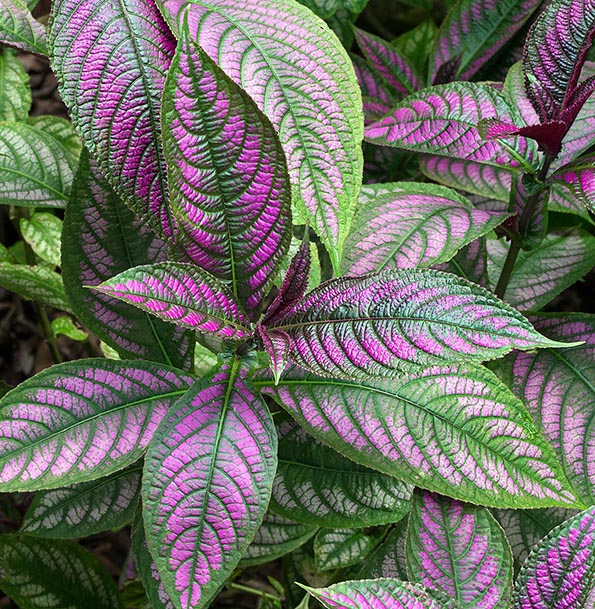Family : Acanthaceae

Text © Pietro Puccio

English translation by Mario Beltramini

The Strobilanthes dyeriana is a splendid acanthaceous of Myanmar humid forests © Giuseppe Mazza
The name of the genus is the combination of the Greek substantives “στρόβιλος” (strobilos) = pine cone, cone, and “ἄνθος” = flower, with reference to the shape of the inflorescence; the species is honoured to the English botanist William Turner Thistleton Dyer (1843-1928).
Common names: Burma conehead, Persian shield, royal purple plant (English); escudo persa, escudo pérsico (Spanish).
The Strobilanthes dyeriana Mast. (1893) is a herbaceous species, tending to become semi-woody with the age, brushy, evergreen, 0,3-1 m tall, with opposite simple, coarse, ovate-lanceolate leaves with slightly toothed margins and pointed apex, 10-16 cm long and 5-7 cm broad, of dark green colour, in particular along the veins, with iridescent metallic grey and purple shades above, of uniform purple colour below. Erect panicle inflorescences, about 15 cm long, with imbutiform flowers, about 3 cm long, of pale violet colour, subtended by green bracts. The fruits are oblong capsules containing 4 seeds.
It reproduces by seed, in particularly draining and light loam maintained humid at the temperature of 24-26 °C, but usually and easily by division and by apical cutting, in spring-summer, seen the facility of rooting, also simply in siliceous sand, agri-perlite or water, in ambient with high temperature and humidity. Species with particularly ornamental foliage, cultivable in the tropical and humid subtropical climate zones as isolated specimen, for edges, also mixed, and as ground cover, in semi-shaded or shaded position to enhance its colour, even if it bears the direct sun of the first morning hours, and sheltered from the wind. It requires a light and aerated loam, rich of organic substance, maintained constantly humid, but without stagnations, slightly acidic to neutral; it does not bear temperatures around the 0 °C, unless exceptional or for a very short period, in such case it can lose the whole aerial part, but can grow again from the base in spring if well mulched. Useful are light periodical prunings for a more compact appearance and the elimination of the inflorescences upon their appearance to the benefit of the foliage.
In the zones less favoured by the climate it can be cultivated as annual, utilizing young plants obtained by cuttings in summer and sheltered in winter in a protected location, to be then planted in open air in spring. Cultivable also in pot, with the forementioned modalities, in greenhouses and in winter gardens or for the decoration of luminous interiors, with lowest winter temperatures not under the 15 °C and high ambient humidity, over the 50%, this last being difficult to obtain and maintain in a flat. In order to increase the humidity one can make recourse to frequent nebulizations or to have the shrewdness of placing the pot on a saucer of large diameter filled with crushed stones, or other inert material, and partially with water, whose level must not reach the bottom of the pot, in order to create a humid microenvironment around the plant. Waterings and nebulizations must be done with non calcareous chlorine free water and at ambient temperature, utilizing, when possible, rainwater. Useful are from spring to autumn monthly fertilizations with hydrosoluble balanced products for acidophilic plants, at half the dosage of what recommended in the package.
The contact with the plant may cause allergic reactions in particularly sensitive persons.
Synonyms: Perilepta dyeriana (Mast.) Bremek. (1944).
